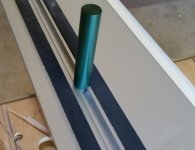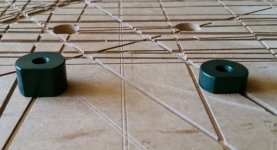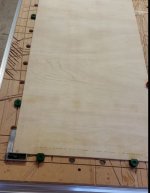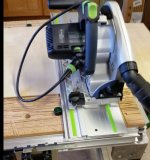Review of anodized aluminum dogs for the Festool MFT/3 by Fine Tool Works
I was asked to review some new bench dogs made by Fine Tool Works for use in the MFT/3. I have been using them on various projects over the last several weeks from construction related tasks to some fine woodworking and I purposely relied only on these dogs for any rips and cross-cuts with my MFT/3 instead of Festool’s standard fence and rail set-up. After using them in my shop I can honestly say that these have become one of my favorite MFT/3 accessories and they have changed the way I work with my MFT/3.
[attachimg=7]
In the interest of full disclosure, Fine Tool Works send me three different pairs of dogs to review that included a pair of Short Dogs with a 9.6mm head height, a pair of Top Dogs with a 16mm head height and a set of Hot Dogs for use with a guide rail to align the rail with the holes in the MFT/3. All of the dogs were anodized in green and featured internal threads (M8 x 1.25 all the way through in the Short Dogs and Top Dogs) and ¼ - 20 in the Hot Dogs. The Short Dogs and Top Dogs allow you to secure them to the MFT table with the knobs from Festool’s Clamping Elements. They were machined extremely well and they fit the MFT/3 holes securely without any slop and so I found that I did not need to use the clamps to secure them. I tried them all in a variety of holes in a couple of different MFT/3 tables and they all fit very well. While I did not try this, the through holes would allow you to secure a clamp or other accessories to the top of each dog which could come in handy for certain applications. I could see using a toggle clamp to secure work to the top in lieu of using Festool’s Quick Clamps, for example. The Hot Dogs had a hex bolt and it was easy to secure them to the bottom of the Guide Rail for accurate positioning on the MFT/3 top using the various holes in the top. I used these dogs with long and short rails and it was easy to position the rail. Since the Hot Dogs allow a bolt in the top and are threaded for ¼-20 threads, I believe that I can utilize them with other rail systems such as Mafell’s F rails. The t-track of Mafell’s rails is thinner than Festool’s rails and you need to use something like Kreg’s T-Bolt found in the Klamp Block Set in the thinner channel. This would be a quick swap and further adds to the versatility of these dogs. While I have not tried this yet, this will come in handy to be able to use different rail systems with the MFT/3 and still get accurate results ripping and cross-cutting.
Utilizing both the Hot Dogs attached to a rail and two of the dogs I could get dead-nuts accurate cross-cuts in a variety of materials and a variety of thicknesses. I also used just a pair of Short Dogs and a pair of Hot Dogs to cut material from less than a ¼ inch thick to 8/4 material and the results were spot on each and every time with both methods. This was fast and repeatable and it allowed me to utilize the entire surface of the MFT/3. Set-ups were quick and it was easy to reposition the dogs for the next application without messing around with the Festool Fence of the MFT/3. Using the grid holes of the MFT/3 allowed for accurate 90 degree and 45 degree cuts. Other angles would need to use a wedge of some kind to get the right angle so the dogs would not replace the need for Festool’s protractor head, but for the bulk of cuts that I make these dogs work just fine.
[attachimg=2]
[attachimg=5]
[attachimg=6]
The dogs themselves are unique from other dogs I own and have used. There is a flat surface machined on one face of each dog and this is aligned to the edge of the MFT/3 holes in the top. Other dogs are round and they are offset from the edge of the holes. A flat surface aligned with the edge of the holes makes it easy to measure since you do not need to calculate any offsets. In my work this is not really much of an issue, but it is nice to know exactly where the flat edge rests. In use I found the flat edge engaged the edge of my material well and it helped me ensure I was square to my guide rail.
I also employed the clamping piece of the Clamping Elements and it worked great holding material for sawing and sanding in this configuration. Coupled with the Short Dogs, I could sand material 10mm thick and greater without the risk of sanding the tops of each dog. I have done this more than once with the heads of the Clamping Elements and having the Short Dogs was great. I did have to add spacers on a couple of pieces I sanded that were less than 10mm, but for most of my work the Short Dogs worked great. The Top Dogs worked very well for thicker stock. If I had to get only get one size, though, I would choose the Short Dogs. I never thought I was lacking adequate material support with the Short Dogs and I think they are more versatile since they accommodate a wider range of thicknesses. If I was working with predominately thicker wood, then the Top Dogs would work fine and provide a little more support. Having a set of each one allows you to have the right dog for each application.
[attachimg=3]
My favorite set of dogs was the pair of Hot Dogs. These dogs were game changing to how I work and it is one of those things that you wonder how you got along without them. They allowed me to secure the guide rail in any configuration of holes and not have to worry about it moving. I could also set it once and reuse the same kerf over and over. The 102mm length of each dog allowed these to be used in various thicknesses of material. Simple raise and lower the rail to fit the material you are cutting. I found that keeping the Hot Dogs loosely secured to the rail best for initial set-up. If I secured them too tightly it made positioning the rail in the holes more difficult. As I mentioned before, I achieved perfect 90 degree cuts over and over using 2-3 dogs and the Hot Dog set-up. I could easily clamp my material and my cuts were perfect. No testing for square or using any set-ups to check for accuracy. Place a couple of dogs and position the rail with the Hot Dogs and that was it. This is my new method of ripping and cross-cutting when I do not need any odd angles since it is so fast and easy to set-up. Like I said, this is game changing for me.
[attachimg=4]
All in all I highly recommend these dogs for anyone utilizing an MFT/3 or work-top based on the MFT/3 grid. These dogs are extremely well made and easy to set-up and use. I highly recommend a pair of the Hot Dogs and the Short Dogs to get started. Two pairs of Short Dogs or one pair coupled with a pair of Top Dogs will get you started and allow you to utilize the dogs for a variety of operations and set-ups on the MFT/3. I really could not find any faults with these accessories of any kind. They are well made, durable, perfect fit and finish and priced competitively. I think that they provide an excellent value.
For more information visit www.FineToolWorks.com or visit Clermont’s Ultimate Tool Supply Inc. at www.UltimateTools.ca.
I was asked to review some new bench dogs made by Fine Tool Works for use in the MFT/3. I have been using them on various projects over the last several weeks from construction related tasks to some fine woodworking and I purposely relied only on these dogs for any rips and cross-cuts with my MFT/3 instead of Festool’s standard fence and rail set-up. After using them in my shop I can honestly say that these have become one of my favorite MFT/3 accessories and they have changed the way I work with my MFT/3.
[attachimg=7]
In the interest of full disclosure, Fine Tool Works send me three different pairs of dogs to review that included a pair of Short Dogs with a 9.6mm head height, a pair of Top Dogs with a 16mm head height and a set of Hot Dogs for use with a guide rail to align the rail with the holes in the MFT/3. All of the dogs were anodized in green and featured internal threads (M8 x 1.25 all the way through in the Short Dogs and Top Dogs) and ¼ - 20 in the Hot Dogs. The Short Dogs and Top Dogs allow you to secure them to the MFT table with the knobs from Festool’s Clamping Elements. They were machined extremely well and they fit the MFT/3 holes securely without any slop and so I found that I did not need to use the clamps to secure them. I tried them all in a variety of holes in a couple of different MFT/3 tables and they all fit very well. While I did not try this, the through holes would allow you to secure a clamp or other accessories to the top of each dog which could come in handy for certain applications. I could see using a toggle clamp to secure work to the top in lieu of using Festool’s Quick Clamps, for example. The Hot Dogs had a hex bolt and it was easy to secure them to the bottom of the Guide Rail for accurate positioning on the MFT/3 top using the various holes in the top. I used these dogs with long and short rails and it was easy to position the rail. Since the Hot Dogs allow a bolt in the top and are threaded for ¼-20 threads, I believe that I can utilize them with other rail systems such as Mafell’s F rails. The t-track of Mafell’s rails is thinner than Festool’s rails and you need to use something like Kreg’s T-Bolt found in the Klamp Block Set in the thinner channel. This would be a quick swap and further adds to the versatility of these dogs. While I have not tried this yet, this will come in handy to be able to use different rail systems with the MFT/3 and still get accurate results ripping and cross-cutting.
Utilizing both the Hot Dogs attached to a rail and two of the dogs I could get dead-nuts accurate cross-cuts in a variety of materials and a variety of thicknesses. I also used just a pair of Short Dogs and a pair of Hot Dogs to cut material from less than a ¼ inch thick to 8/4 material and the results were spot on each and every time with both methods. This was fast and repeatable and it allowed me to utilize the entire surface of the MFT/3. Set-ups were quick and it was easy to reposition the dogs for the next application without messing around with the Festool Fence of the MFT/3. Using the grid holes of the MFT/3 allowed for accurate 90 degree and 45 degree cuts. Other angles would need to use a wedge of some kind to get the right angle so the dogs would not replace the need for Festool’s protractor head, but for the bulk of cuts that I make these dogs work just fine.
[attachimg=2]
[attachimg=5]
[attachimg=6]
The dogs themselves are unique from other dogs I own and have used. There is a flat surface machined on one face of each dog and this is aligned to the edge of the MFT/3 holes in the top. Other dogs are round and they are offset from the edge of the holes. A flat surface aligned with the edge of the holes makes it easy to measure since you do not need to calculate any offsets. In my work this is not really much of an issue, but it is nice to know exactly where the flat edge rests. In use I found the flat edge engaged the edge of my material well and it helped me ensure I was square to my guide rail.
I also employed the clamping piece of the Clamping Elements and it worked great holding material for sawing and sanding in this configuration. Coupled with the Short Dogs, I could sand material 10mm thick and greater without the risk of sanding the tops of each dog. I have done this more than once with the heads of the Clamping Elements and having the Short Dogs was great. I did have to add spacers on a couple of pieces I sanded that were less than 10mm, but for most of my work the Short Dogs worked great. The Top Dogs worked very well for thicker stock. If I had to get only get one size, though, I would choose the Short Dogs. I never thought I was lacking adequate material support with the Short Dogs and I think they are more versatile since they accommodate a wider range of thicknesses. If I was working with predominately thicker wood, then the Top Dogs would work fine and provide a little more support. Having a set of each one allows you to have the right dog for each application.
[attachimg=3]
My favorite set of dogs was the pair of Hot Dogs. These dogs were game changing to how I work and it is one of those things that you wonder how you got along without them. They allowed me to secure the guide rail in any configuration of holes and not have to worry about it moving. I could also set it once and reuse the same kerf over and over. The 102mm length of each dog allowed these to be used in various thicknesses of material. Simple raise and lower the rail to fit the material you are cutting. I found that keeping the Hot Dogs loosely secured to the rail best for initial set-up. If I secured them too tightly it made positioning the rail in the holes more difficult. As I mentioned before, I achieved perfect 90 degree cuts over and over using 2-3 dogs and the Hot Dog set-up. I could easily clamp my material and my cuts were perfect. No testing for square or using any set-ups to check for accuracy. Place a couple of dogs and position the rail with the Hot Dogs and that was it. This is my new method of ripping and cross-cutting when I do not need any odd angles since it is so fast and easy to set-up. Like I said, this is game changing for me.
[attachimg=4]
All in all I highly recommend these dogs for anyone utilizing an MFT/3 or work-top based on the MFT/3 grid. These dogs are extremely well made and easy to set-up and use. I highly recommend a pair of the Hot Dogs and the Short Dogs to get started. Two pairs of Short Dogs or one pair coupled with a pair of Top Dogs will get you started and allow you to utilize the dogs for a variety of operations and set-ups on the MFT/3. I really could not find any faults with these accessories of any kind. They are well made, durable, perfect fit and finish and priced competitively. I think that they provide an excellent value.
For more information visit www.FineToolWorks.com or visit Clermont’s Ultimate Tool Supply Inc. at www.UltimateTools.ca.







